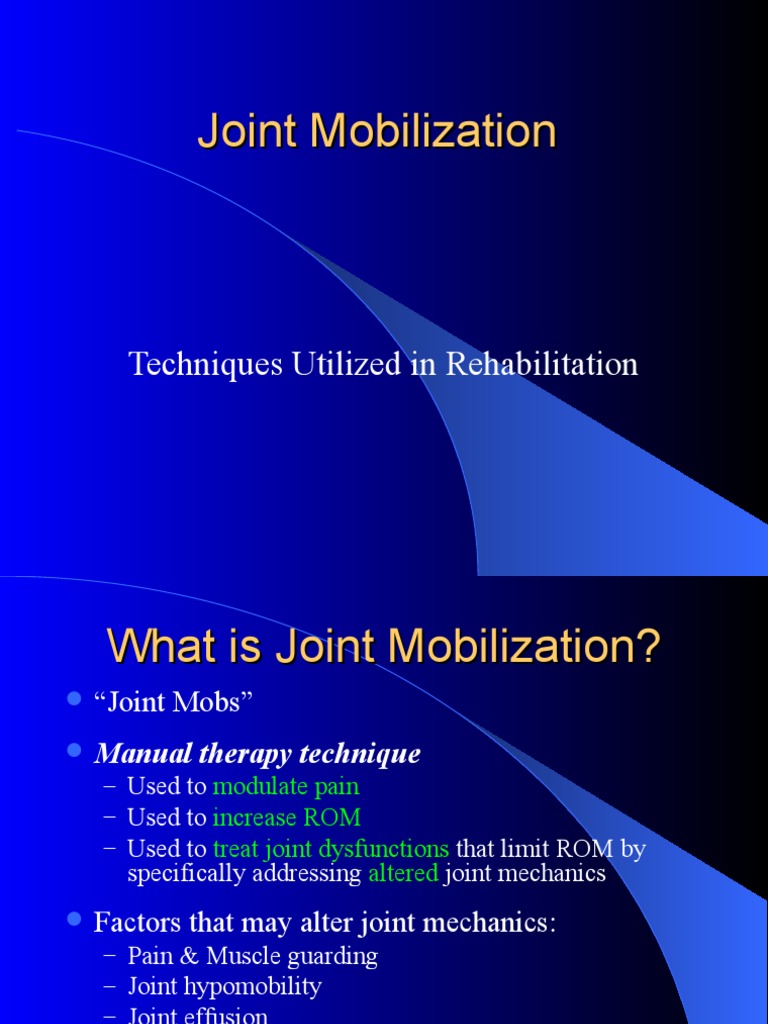Unlocking Flexibility: Exploring Joint Mobilization Methods
Joint mobilization is a therapeutic technique that focuses on improving joint movement, reducing pain, and enhancing flexibility. In this comprehensive exploration, we delve into the significance of joint mobilization methods, their applications, and the positive impact they can have on overall joint health.
Understanding Joint Mobilization: A Therapeutic Approach
Joint mobilization is a hands-on therapeutic approach performed by trained healthcare professionals, often physiotherapists or chiropractors. It involves gently moving the joints through their natural range of motion, aiming to restore normal function, alleviate pain, and enhance flexibility. This method is particularly beneficial for individuals experiencing joint stiffness or restricted movement.
The Mechanics of Joint Mobilization: How It Works
The mechanics of joint mobilization involve the application of controlled and gentle forces to specific joints. Therapists use their hands to guide the joint through various movements, including oscillations, stretches, and gliding motions. These controlled movements stimulate the joint’s synovial fluid, promoting lubrication and nourishing the joint surfaces.
Indications for Joint Mobilization: When It’s Beneficial
Joint mobilization is beneficial for a variety of musculoskeletal conditions. It is commonly employed for individuals with joint pain, stiffness, or impaired mobility. Conditions such as osteoarthritis, frozen shoulder, and certain types of injuries respond well to joint mobilization. It is also utilized in post-surgical rehabilitation to enhance joint recovery.
Types of Joint Mobilization Techniques
Joint mobilization encompasses various techniques tailored to different joints and conditions. These techniques may include passive oscillations, sustained stretches, and rhythmic joint movements. The selection of specific techniques depends on the individual’s condition, the joint involved, and the therapist’s assessment of the patient’s needs.
Benefits of Joint Mobilization: Enhancing Joint Function
The primary goal of joint mobilization is to enhance joint function, and it offers a range of benefits. Improved joint mobility, increased flexibility, and reduced pain are common outcomes. Additionally, joint mobilization contributes to better proprioception, the body’s awareness of its joint position, leading to enhanced balance and coordination.
Safety and Precautions in Joint Mobilization
While joint mobilization is generally safe, it’s essential to approach it with consideration for individual health conditions. Individuals with certain joint disorders, fractures, or inflammatory conditions may require modifications or alternative approaches. Proper assessment and communication between the therapist and the patient ensure a safe and effective session.
Integration with Exercise Therapy: A Comprehensive Approach
Joint mobilization often complements exercise therapy for a comprehensive approach to musculoskeletal health. Therapists may prescribe specific exercises to reinforce the benefits of joint mobilization, supporting the strengthening of muscles around the treated joint and promoting long-term stability and functionality.
Patient Education and Empowerment
Patient education is a crucial component of joint mobilization therapy. Therapists educate patients about their condition, the goals of joint mobilization, and exercises they can perform at home. Empowering patients with knowledge fosters active participation in their recovery, leading to better outcomes and long-term joint health.
Incorporating Joint Mobilization Methods into Care Plans
For individuals seeking the benefits of joint mobilization, consulting with a qualified healthcare professional is the first step. These professionals assess the individual’s condition, develop personalized care plans, and integrate joint mobilization methods where appropriate. Regular sessions and consistency in following the prescribed exercises contribute to optimal results.
Discover the Benefits at Health-Sourcing.com
Explore more about joint mobilization methods and their positive impact on joint health at health-sourcing.com. Whether you’re managing joint pain, recovering from an injury, or aiming to enhance joint flexibility, understanding the significance of joint mobilization can guide you on the path to improved musculoskeletal well-being.



